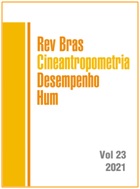Prevalence of Active Play in Brazilian children and adolescents: an updated systematic review for the Brazil's Report Card
DOI:
https://doi.org/10.1590/1980-0037.2021v23e84442Keywords:
Saúde Mental, Atenção Psicossocial, Reforma Psiquiátrica.Abstract
This paper is an update of the systematic review on Active Play published in 2018 by Mendes et al. This systematic review included studies published between 2018 and 2019. The search for potential articles was performed on the following electronic databases: Pubmed/Medline, Web of Science, Bireme, Scielo and Scopus. Initially, 471 papers met the eligibility criteria. However, after deeply analyzed, only two studies remained and were included in the present review. From these articles only one presented individual information on play activity among adolescents age (12-17 years) from Curitiba-PR and it reveals that 77,2% of them were physically active in their free time. The other study included was about the preferences for leisure activities among adolescents from Florianopolis-SC participants in two cross sectional studies in 2001 and 2011. It showed a significant reduction in the preferences for practicing physical activities, while the opposite occurs with sedentary activities like watching TV, playing video games, and using computers. These results along with the inconsistencies in benchmarks of the domain active play among countries involved in the Global Matrix 3.0 made clear the necessity of a standard definition and a proper tool to measure it.
References
Stratton G, Edwards L, Tyler R, Blain D, Bryant A, Jones A, et al. Active Healthy Kids Wales 2018 Report Card. Available from: http://www.activehealthykidswales.com/
Aubert S, Barnes JD, Abdeta C, Nader PA, Adeniyi AF, Aguilar-Farias N, et al. Global Matrix 3.0 physical activity Report Card grades for children and youth: Results and analysis from 49 countries. J Phys Act Health 2018;15(S2):S251-S273.
Mendes AA, Lopes WA, Locateli JC, de Oliveira GH, Bim RH, Simões CF, et al. The prevalence of active play in Brazilian children and adolescents: A systematic review. Rev Bras Cineantropom Desempenho Hum 2018;20(4):395–405.
Moher D, Liberati A, Tetzlaff J, Altman DG. Preferred reporting items for systematic reviews and meta-analyses: the PRISMA statement. J Clin Epidemiol 2009;62(10):1006–12.
Nardo Junior N, Westphal G, Pereira IAS, Borim MLC. Prevalence of active play in Brazilian children and adolescents: a systematic review. PROSPERO 2021 CRD42021236338. PROSPERO 2021 CRD42021236338 Available [Internet]. 2021;1–5. Available from: https://www.crd.york.ac.uk/prospero/display_record.php?ID=CRD42021236338
Silva AA de P da, Camargo EM de, Silva AT da, Silva JSB, Hino AAF, Reis RS. Characterization of physical activities performed by adolescents from Curitiba, brazil. Rev Bras Med Esporte. 2019;25(3).
Bertuol C, Silva KS, Cordeiro V, Filho B, Da A, Bandeira S, et al. Preference for leisure activities among adolescents in southern Brazil: what changed aaer a decade? Rev Psicol Deporte 2019;28:71–80.
HALO. ParticipACTION. The Brain + Body Equation: Canadian kids need active bodies to build their best brains. The 2018 ParticipACTION Report Card on Physical Activity for Children and Youth [Internet]. 2018 [cited 2021 Oct 19]. Available from: www.participACTION.com/reportcard.
Truelove S, Vanderloo LM, Tucker P. Defining and Measuring Active Play Among Young Children: A Systematic Review. J Phys Act Health 2017;14(2):155-166.
Takken T, Jong N, Duijf M, van den Berg S, Wendel-Vos W. Results from the Netherlands’ 2018 Report Card and Report Card+ on physical activity for children and youth with and without chronic medical condition. Public Health 2020;185:161–6.
Takken T, de Jong N; Dutch Physical Activity Report Card Study Group. Results from the Netherlands’ 2018 report card on physical activity for children and youth. J Phys Act Health 2018;15(S2):S388-S389.
Mileva B. Results From Bulgaria’s 2018 Report Card on Physical Activity for Children and Youth. J Phys Act Health 2018;15(S2):S326–7.
Smith M, Ikeda E, Hinckson E, Duncan S, Maddison R, Meredith-Jones K, Walker C, et al. Results from New Zealand’s 2018 report card on physical activity for children and youth. J Phys Act Health 2018;15(S2):S390–2.
Nigerian Report Card on Physical Activity for Children and Youth [Internet]. 2018. Available from: www.nigerianheart.org
Bhawra J, Ranjani H, Krishnaveni G v, Anjana RM, Kumaran K. THE 2018 India Report Card On [Internet]. Available from: www.activehealthykidsindia.com
Roman-Viñas B, Zazo F, Martínez-Martínez J, Aznar-Laín S, Serra-Majem L. Results From Spain’s 2018 Report Card on Physical Activity for Children and Youth. J Phys Act Health 2018;15(S2):S411-S412.
Liu Y, Tang Y, Cao Z-B, Zhuang J, Zhu Z, Wu X-P, et al. Results From China’s 2018 Report Card on Physical Activity for Children and Youth. J Phys Act Health 2018; 15(S2):S333-S334.
Munambah NE. Active Healthy Kids Zimbabwe. Physical Activity and the Nutritional status of school-aged children in Zimbabwe: current research evidence and policy implications. [Internet]. Harare, Zimbabwe; 2018. Available from: www.activehealthykidszimbabwe.com
Tladi DM, Monnaatsie M, Shaibu S, Sinombe G, Mokone GG, Gabaitiri L, et al. Results from Botswana's 2018 Report Card on Physical Activity for Children and Youth. J Phys Act Health 2018;15(S2):S320-S322.



